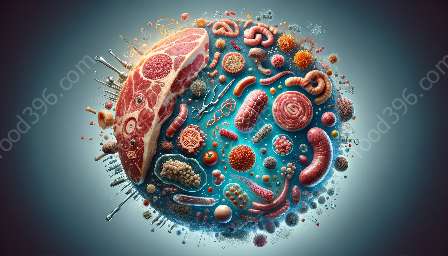Meat microbiology involves the study of microorganisms in meat and meat products. This includes the assessment of the microbiological standards set for meat products, which are crucial for ensuring food safety and quality. Microbiological standards play a significant role in meat science by providing guidelines for acceptable levels of microorganisms in meat products and aiding in the development of preservation and processing methods.
Understanding Meat Microbiology
Meat microbiology examines the various microorganisms that can occur in raw or processed meat, including bacteria, molds, and yeasts. These microorganisms can impact the safety and shelf life of meat products, making it essential to establish microbiological standards to regulate their presence. Factors such as temperature, moisture, pH, and packaging can influence the growth and survival of microorganisms in meat, emphasizing the need for specific standards to ensure consumer safety.
It's important to note that the microbiological quality of meat is affected by factors such as animal health, hygiene during processing, and storage conditions. By monitoring and controlling these factors, the industry can adhere to microbiological standards and provide safe meat products to consumers.
Intersection of Meat Microbiology and Meat Science
When examining microbiological standards for meat products, it's crucial to consider how they intersect with meat science. Meat science involves the study of the processes and technologies used in meat production, including the handling, processing, and preservation of meat. Microbiological standards form an integral part of meat science by guiding the implementation of food safety measures throughout the meat production chain.
One of the key aspects of meat science is the development and validation of interventions to control and minimize microbial contamination in meat products. This includes strategies such as thermal processing, irradiation, and the use of antimicrobial agents to meet microbiological standards and ensure consumer protection. Furthermore, meat scientists work closely with microbiologists to understand the behavior of microorganisms in meat and develop effective control measures.
Exploring Microbiological Standards
Microbiological standards for meat products are established by regulatory authorities to mitigate the risks associated with microbial contamination and to safeguard public health. These standards define permissible levels of microorganisms, including pathogens and spoilage organisms, in meat and meat products. Compliance with these standards is essential for meat processors and retailers to ensure their products are safe for consumption.
The most common microbiological standards for meat products include limits for bacterial pathogens such as E. coli, Salmonella, Listeria monocytogenes, and Staphylococcus aureus. Additionally, standards address the presence of spoilage microorganisms that can affect the quality and shelf life of meat products, emphasizing the need for proper handling and storage practices.
Impact on Food Safety
The implementation of microbiological standards for meat products directly impacts food safety. By adhering to these standards, meat processors and distributors can reduce the likelihood of foodborne illnesses caused by pathogenic microorganisms. Moreover, maintaining microbial control in meat products helps in preventing spoilage and preserving the sensory attributes of the meat, ensuring a positive consumer experience.
Consumers rely on microbiological standards to make informed decisions about the safety and quality of meat products. The presence of clear and well-defined standards provides assurance that the meat they consume meets specific safety criteria, leading to increased trust and confidence in the food supply chain.
Conclusion
Microbiological standards for meat products are essential for regulating the microbial quality of meat and ensuring consumer safety. They serve as a cornerstone of meat microbiology and meat science, guiding the industry in the production of safe and high-quality meat products. By understanding and following these standards, stakeholders across the meat supply chain can contribute to the overall goal of providing consumers with wholesome and safe meat products.

